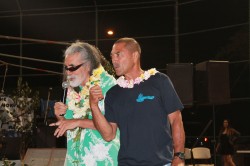Green Guerillas Visit Food Forest and MMS
Molokai Seed Savers News Release
A hardy group of Green Guerillas (Seed Savers over age 65) braved the rain and winds for a tour of the Sustainable Molokai Food Forest under the direction of Fred Richardson. Fred explained the design of the forest, the water flow and catchment, terracing, plantings, composting and future goals. An area of land that had been left without management where the soil was running off onto a road at the bottom of the hill has been turned into a beautiful forest with hard wood trees, fruit trees, construction grade bamboo and vegetables. A community work day is held the fourth Saturday of every month and seeds, cuttings and plants are available as they are produced in the forest.…











